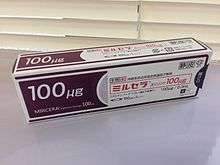Methoxy polyethylene glycol-epoetin beta
Methoxy polyethylene glycol-epoetin beta is the active ingredient of a drug marketed by Hoffmann-La Roche under the brand name Mircera. Mircera is a long-acting erythropoietin receptor activator (CERA) indicated for the treatment of patients with anaemia associated with chronic kidney disease. It is the first approved, chemically modified erythropoiesis-stimulating agent (ESA). Mircera is supplied as a solution in pre-filled syringes for intravenous or subcutaneous administration. Mircera was approved for use in Europe in July 2007 by the European Commission, in September 2007 by the Swissmedic, and in November 2007 by the U.S. Food and Drug Administration for use in the United States.
| Clinical data | |
|---|---|
| AHFS/Drugs.com | mircera |
| License data | |
| ATC code | |
| Legal status | |
| Legal status |
|
| Identifiers | |
| CAS Number | |
| DrugBank | |
| ChemSpider |
|
| UNII | |
| KEGG | |
| ChEMBL | |
| | |

Methoxy polyethylene glycol-epoetin beta is made from erythropoietin by chemically linking the N-terminal amino group or the ε-amino group of any lysine present in the protein with methoxy polyethylene glycol butanoic acid. The average molecular weight is approximately 60 kDa.[1] The drug stimulates erythropoiesis by interacting with the erythropoietin receptor on progenitor cells in the bone marrow.[1] It has a reduced receptor binding activity compared to other ESAs and but retains in vivo activity due to an extended serum half-life. It has an in vivo half-life of around 135 hours (5.6 days) as compared to darbepoetin alfa which has a half life of around 21 to 70 hours, the half life of which is three times that of the naturally occurring erthropoietin in the body.
Patent infringement claims
A U.S. Federal Appeals Court ruled 15 September 2009 that Mircera infringes a patent held by Amgen Inc. The court refused to lift an injunction entered in the fall of 2008 which barred Roche from selling Mircera in the United States.[2] However, the injunction has since expired and Mircera is available on the US market since 2015.[3]
Use in sports
Mircera can reportedly replace traditional EPO drugs as blood doping agent in endurance sports. The drug appears to fall under section S2 of the list of substances officially prohibited - in competition and out of competition - in France and by the World Anti-Doping Agency.[4]
On July 17, 2008, Italian bicycle racer Riccardo Riccò was disqualified from the Tour de France after reports that a urine sample tested positive for Mircera.[5][6] There had not previously been any public acknowledgment that a test for the new drug was being administered, or had even been developed yet. The Tour de France testing was done under the auspices of the French Cycling Federation and the French Anti-Doping Agency, not the Union Cycliste Internationale.[7][8]
See also
References
- Macdougall IC, Eckardt KU (September 2006). "Novel strategies for stimulating erythropoiesis and potential new treatments for anaemia". Lancet. 368 (9539): 947–53. doi:10.1016/S0140-6736(06)69120-4. PMID 16962885. S2CID 43889549.
- Kendall B (15 September 2009). "Update: US Court Won't Disturb Injunction Against Roche Anemia Drug". Dow Jones Newswires Tuesday.
- "FMC aims for 110,000 U.S. patients to be on Mircera in first-quarter". Reuters. 24 April 2017. Retrieved 23 May 2017.
- "Substances et méthodes interdites en permanence (en et hors compétition)" (PDF) (in French). Archived from the original (PDF) on 12 November 2008. (Décret no 2008-35 du 10 janvier 2008 portant publication de l’amendement à l’annexe de la convention contre le dopage, adopté par le groupe de suivi lors de sa 26e réunion le 12 novembre 2007 à Madrid.)
- Pelkey C (17 July 2008). "Riccardo Riccò tests positive; Saunier Duval team withdraws from Tour de France". VeloNews. Archived from the original on 5 August 2009.
- Wyatt E (18 July 2008). "Tour de France team out after test". The New York Times.
- "The 2008 Tour de France under the control of the French Cycling Federation". Amaury Sport Organisation. 6 March 2008. Archived from the original on 16 March 2008. Retrieved 17 July 2008.
- "L'Agence française de lutte contre le dopage" (in French). Retrieved 17 July 2008.